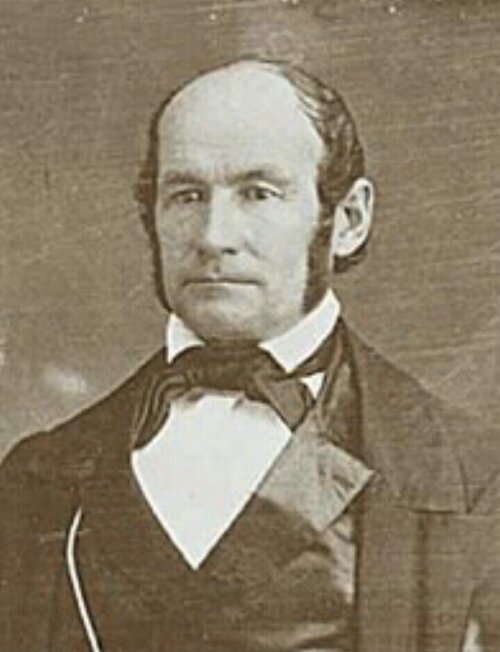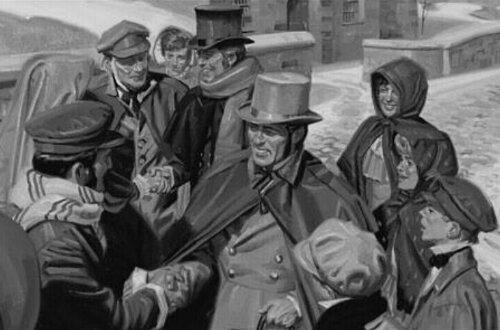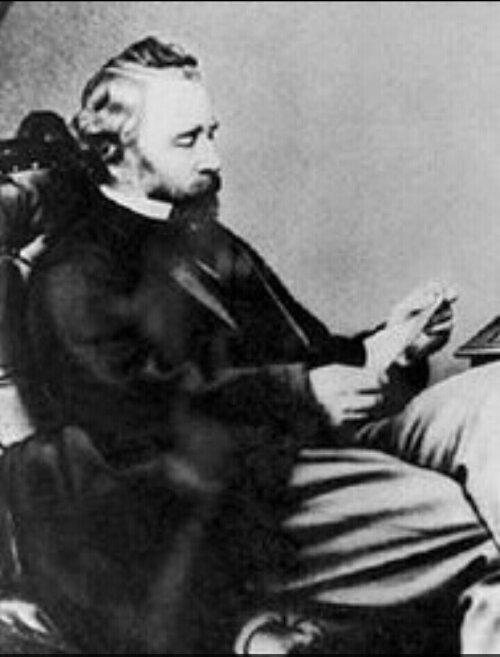With the upcoming Mormon Pageant in Preston, England, it’s a wonderful opportunity to consider a more complete account of the lives of those first British Latter-Day Saint converts.
I believe that the more information one has about an event or period in history then the better one can understand what really occurred.
Just like being a detective or forensic investigator, the more accounts we have to consider, the closer we come to the truth of the matter.
Chris Ralph has studied the lives of the first converts to Mormonism in Britain to reveal the bigger picture.
Authored by Christopher Ralph. Chris has a Masters Degree in History from the University of the West of England, (2011). His dissertation was on the subject of “Bristol’s Earliest Mormon Converts”.
PART ONE: Truth Will Prevail
On 19th July 1837 Heber Chase Kimball and six other elders of the Church of Jesus Christ of Latter-day Saints, (commonly known as “Mormons”), disembarked at Liverpool. This was the first time Mormon missionaries had been sent anywhere outside of North America. They made their way to Preston a few days later and there saw a political banner proclaiming ‘Truth Will Prevail’, for they had arrived in the midst of a General Election campaign following the recent accession of the 18 year old Queen Victoria. This, they felt, was an excellent omen that their efforts in spreading the LDS gospel in that place would meet with success, and the political motto was duly adopted as their own.
Heber Chase Kimball, who led the first Mormon mission to Britain in 1837
So began an attempted Mormon Conquest of The British Isles, one which enjoyed notable success in many small pockets here and there over the next fifteen years. By 1851 there were approximately 32,000 Mormons in this land, which represented two-thirds of the global Mormon population at that time. However, the British LDS church was viewed not as an established outpost, but merely as a seed-bed, a resource for providing a steady supply of converts to populate and strengthen the American church, whose headquarters by 1847 were relocated from Nauvoo, Illinois to the Salt Lake Valley in the Rocky Mountains. British Converts soon learnt that their new faith required them, as soon as they were able, to leave behind their native land and non-Mormon family members, and travel to that Land of Zion, where God was establishing a theocracy which would govern the Earth for a thousand years; they were taught that the time was near at hand when national governments would fail, anarchy would reign, and no safety would be found outside of Zion. The message Heber Kimball and his immediate successors delivered was that an angel had in their generation appeared to a latter-day prophet Joseph Smith, and the Lord’s chosen people were being gathered one last time into Zion. Soon, with fiery judgments, would come the winding up of all other false systems. Salvation was to be had only in Mormonism. It was the only means available to mankind which God now authorised. All other creeds were an abomination in his sight.
This sense of extreme urgency resonated with the unsettled times through which many of the British hearers of this message were living, for it was an age of upheaval, most noticeably in terms of population movement. The younger elements of the British rural labour force were steadily being enticed by higher wages to the new industrial centres which were located within larger towns and cities. Tens of thousands were annually relocating to urban areas, where, in addition to higher wages, they also encountered indifferent working conditions, cramped housing, poor sanitation, ill-health, and large fluctuating impersonal communities where crime proliferated, all far different from the small familiar rural hamlets and villages they had left behind. There had not been such wholesale social change for centuries, and for many it signalled that the old order, (England’s green and pleasant land), was being overtaken by the dark Satanic mills of a new uncaring age, and that the world was indeed stumbling towards its end. This belief was especially rife within non-conformist churches, and some, notably Primitive Methodism, were looking to re-establish the church organisation found in the New Testament. Mormonism gave spiritual voice to all these inner forebodings and aspirations, offering new hope, and a practical solution in the form of a Zionist escape route.
Modern LDS artistic representation of early missionaries among their British converts
However, it is not enough to observe Mormonism’s spread in Britain simply in terms of a general top-down overview. In order to appreciate its true impact, the history of British Mormonism must be seen through the eyes of those who actually experienced at first hand this seemingly familiar, yet in reality this wildly different, new gospel. A ‘history from below’ as lived by the rank and file participants, is only way to appreciate events.
The modern LDS church itself promotes a shallow, glossy view of those early times, and perhaps that is not entirely surprising, for it is charged with promoting what many now consider to be a questionable product to prospective tithe-paying devotees, at the same time as attempting to retain within its head-count a rapidly growing number of troubled and disaffected members. The 21st century LDS church is in many respects very unlike its 19th century fore-runner which speculatively sent missionaries to Britain in 1837, although in one important respect it is its equal: it still does not present a full account of itself. Today, however, the LDS church is sophisticated, wealthy, business-savvy, PR-conscious, and carefully selective in which face it presents to the general public. It needs to be because in this age of rapid information exchange, theoretically all have reasonable access to uncomfortable LDS historical information, (which it has always sought to hide from investigators and its rank and file members), and so if the mission of the church is to succeed, the value of objectivity must be downplayed, and emphasis constantly placed upon comforting faith-promoting narratives, even though those narratives are typically unsupported by hard evidence. The church these days therefore teaches a rather diluted and sanitized gospel, still often drawing, nevertheless, upon early pioneer stories of faith and courage in adversity, while ignoring the many untold stories of those whose lives were wrecked or impoverished through their contact with early Mormonism. This is done, of course, in order to project an illusion of continuity and institutional wellbeing.
Only one-quarter of all British converts in the 19th century, managed to fulfil the desired objective of emigrating to America. Of those, a good many did not manage to complete the onward journey to Salt Lake City, and of those who did, a significant proportion became disillusioned, but found themselves so financially and spiritually mired in a strange and intolerant society, that they could not easily escape. They discovered when it was already too late, that ‘Zion’ was not as had been advertised. When the modern LDS church speaks therefore about its wonderful pioneer heritage, it attempts to infer that its neatly packaged accounts smoothed out through repeated telling, are representative of the whole, when in fact they are representative of perhaps no more than 15%. As marketing is the main purpose of the exercise, the version of early Mormon history told by the church today cannot be other than distorted, if not actually by deliberate sanitization, then by the inadequate sample size upon which that history relies. It is not good enough to say that the other 85% do not matter because they lacked faith. We cannot dismiss them in that way and pretend the resulting account is correct simply because we want it to be. The 85% had stories to tell as well, and good reasons for not being among the 15%, and those stories and reasons are as valid and material as any other.
In order to address this significant imbalance therefore, and very much in the spirit of ‘Truth will Prevail’, some of the alternative experiences which have been recorded and researched will follow. These also are a large part of British Mormonism’s past, and deserve to be considered in any British Mormon history or pageant, alongside the 15% sample which the LDS church might choose to showcase.
Take for example the story of George Darling Watt, who was the first man to be baptised in England. The LDS church provides a very interesting account of how Watt won a foot race to the banks of the River Ribble in order to be accorded that unique privilege. The story is designed to convey the fervour of those early converts. However, the equally interesting fact that Watt was later authorised by Brigham Young to take as a plural wife Watt’s own younger half-sister, Jane Brown, (they shared a mother, Mary Ann Wood), and that they became parents of three children, is seldom if ever discussed, even though that also illustrates the degree of fervour with which some accepted the Mormon gospel.
George Darling Watt, the first man baptized in England
One should ask perhaps, why would the LDS church today avoid sharing such an interesting piece of information with its members and the general public? Could it be that it is embarrassed? The early Mormon leaders certainly were not. In what Apostle Wilford Woodruff described at the time (1854) as “the greatest sermon that ever was delivered to the Latter Day Saints since they have been a people,” Brigham Young announced: “I believe in Sisters marrying brothers, and brothers having their sisters for Wives.”
Of course Brigham also taught the Latter-day Saints that the Sun is inhabited, that a man’s glory in the next world depends upon how many wives and children he has in this, that those who enter into mixed race marriages should suffer the penalty of death for breaking God’s law, and that Adam, the first human, is the God we must worship. He taught much which is no longer believed, and yet for over thirty years, (1844-1877), his utterances were God’s word to the Latter-day Saints. Brigham Young was God’s mouthpiece, and latter-day saints were expected to conform their lives accordingly. One wonders how many lived and died actually placing all their trust and belief in such teachings. It is rather a disturbing thought. And even today Brigham Young is revered by Latter-day Saints as having been a prophet, seer and revelator, but most current members have little if any idea of the strange worldview which was forced upon their predecessors.
*************************




Really informative. I look forward to reading more.
Very interesting. Richard Wellington
So far this is interesting and new information for me. Where did you get your 15% vs. 85% data?
The church’s own figures suggest that around 25% of British converts eventually emigrated. Of course, not all reached their destination. Many stopped off at New Orleans, and worked a while to pay their passage by steamer up to St Louis. While at work, and particularly on board they would have heard cautionary tales about disillusioned Mormons who had gone before, and this was enough in some cases to persuade them not to complete the overland leg of the journey.
At St Louis there was a need to buy or hire handcarts or ox-teams and adequate provisions for the 1300 mile trek over the plains. There are instances of people working two or more years there in order to afford all the necessary equipment. For various reasons, some did not persevere with their original plan. All the time rumours circulated, and some defections resulted. Then, as is well known, some died on the trail. According to various reports of visitors to the early SLC, a significant portion of the British and Scandinavian converts felt disillusioned, and would have left if they had felt it both safe and financially viable to do so. Some managed to get away, and returned east, or even managed to get back home again. Others defected to the Reorganites when they witnessed the effects of polygamy at first hand. Others just kept their heads down and did what they had to do to survive, kept their doubts and misgivings to themselves, and accommodated Mormonism in their lives. To varying degrees these were the ones who prospered, and are remembered by posterity.
Factoring all of these possibilities into the equation, my judgment is that no more than 15% of British converts made it all the way to SLC, and fully embraced the brand of Mormonism they encountered there. The actual figure may well be lower than that. It is from that small fraction of the original British Mormon population, that the faith-promoting stories are now derived. It should also be noted that many of the pioneer stories handed down to us are second and third hand, having passed from mouth to mouth within families, and of course they have acquired the kind of pro-Mormon twists and veneers one might expect to find among the survivors of those challenging times; the subsequent generations of those pioneers became, in effect, Mormon history’s winners who, for a time, were privileged to tell the story as they saw it, without any real challenge.
Interesting blog Chris. It IS important to get ‘the rest of the story’. Is it possible to list sources for your information please? I especially enjoyed the part about Darling marrying his half sister. I had read the speech by Brigham Young before but didn’t know this instance of it taking place.
My father came from Wigan and his mother’s family from Preston. My grandmother warned me about Mormon missionaries coming and taking young women through a tunnel to Salt Lake City to become their plural wives. Should have listened to her.
I intend referencing soon, (you’re right, it is essential), but felt the more immediate need to get some information out there just to make others stop and think logically about our past. The tunnel to Utah stories have taken root in the British collective psyche, but in part 2, I will be mentioning some actual instances which may be of further interest.
Thanks Chris. My grandmother was born in the late 19th century and she was really earnest in her warnings about the tunnel to Utah, having heard those stories in her childhood. The warning to me was in 1968 when I was emigrating to Canada and had become a Mormon. She also warned my younger cousin not to talk to those ‘young men’ who came door to door because they would ‘take her’.
Looking forward to the references. I have Mr. Hawthornwaite’s book.
My husband’s convert ancestors came from Ireland and Wales mostly and as you point out in segment two, not all those who left Britain actually made it to ‘the promised land’. The story goes (according to believing LDS who wrote about the ancestors conversions and life in Utah) that ggg Grandfather from Ireland was sent back to Florence, Nebraska by Abraham Smoot to deliver a team of oxen. This occurred in 1860 – 1861.
ggg Grandfather met a woman from England on the journey back to Utah and fell for her. The complicating factor was that he had a fiance from Wales waiting for him in Utah. When they arrived back, supposedly he told the two women “I will marry both of you or no one” so they were married in the Old Endowment House in one ceremony on Oct. 26th 1861. I often wondered how they handled ‘the first night’.
I had exactly the same warning from my own grandfather who was from Rivington/Aspull. He related horrid stories of what had happened to those ‘disappeared’ ladies who managed to get word back home about their terrible fate at the hands of the mormons. There are so many stories that have not been yet told as they are lost in history and buried with those that knew. I do wish I’d heeded my grandfather’s warnings.
Wow! More and more it seems that Facts are coming to wide audience attention that tend to show that the LDS church has no overwhelming claim to being special, much less unique or favored of a heavenly being.
Based upon ancestors of a friend that had ancestors from england — this incest and pedophilia followed these converts to cultland UT.
Chris, I tried looking up more about the Brigham quote, “I believe in Sisters marrying brothers, and brothers having their sisters for Wives.” I have to admit that it seems plausible he was referring to brothers and sisters in the way that Mormons call each other brother and sister even when there is absolutely no blood relation whatsoever. Do you think this quote may be taken out of context in your post, or is there evidence that it was actually promoting the practice of incest? Thanks, Zack